‘As Long as the Party Embraces Trump, It’s Going to Have Trouble’
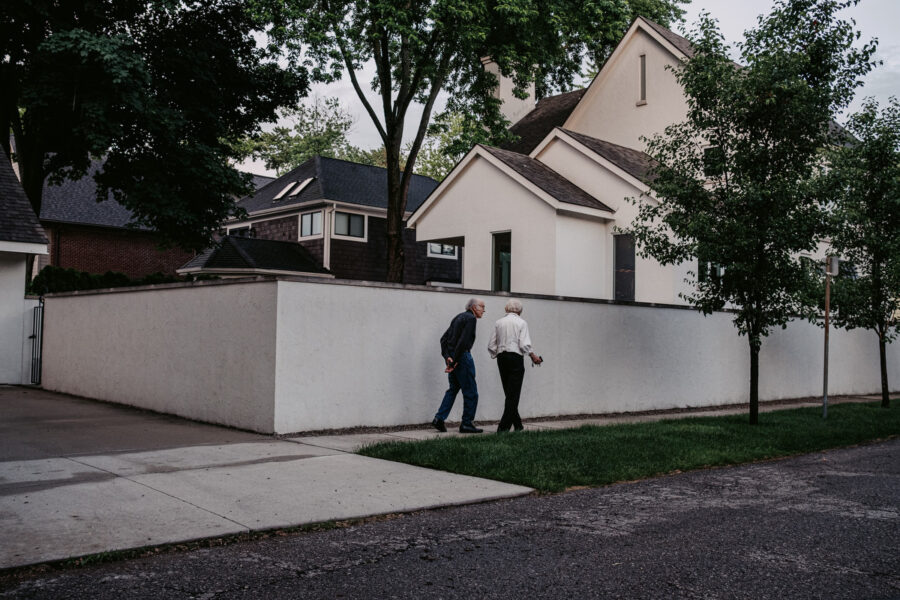
In the aftermath of the 2020 election, the Republican National Committee opted not to order an autopsy into what exactly led to the party’s decline in suburban communities that were, until recently, considered deep red.
But if RNC Chair Ronna Romney McDaniel wanted to understand what happened, she could do worse than to look back at the place she was raised: Oakland County, Michigan.
“Oakland County was kind of the quintessential suburban Republican stronghold over the postwar period,” says Jeff Timmer, a longtime GOP strategist who was executive director of the state party from 2005-2009. It was (and is) a huge source of campaign donations for the party and its candidates. It had massive influence in Lansing, and an influential bipartisan delegation in Washington. It was a must-visit locale for every aspiring Republican presidential candidate.
“When I ran the Michigan Republican Party, we always pointed to Oakland: ‘These guys have got their shit together,’” says Timmer.
To put it bluntly, the shit is no longer together.
Ten years ago, Republicans held two of the four GOP-drawn U.S. House seats in Oakland (the other two were safe Democratic); now, all four are in Democratic hands. Democratic women now represent the Romney family’s hometown in the state House, state Senate and U.S. House (Rep. Haley Stevens). Ten years ago, Brooks Patterson, the silver-tongued sun-God around whom all local politics orbited, was county executive, and Republicans held four of the six countywide elected posts; Democrats now hold five of them, including the executive. After GOP-controlled redistricting in 2012, Republicans had a 14-7 majority on the Oakland County Board of Commissioners; now, Democrats have an 11-10 edge and will control the county-level redistricting process for the first time in a half-century.
The change is happening in lush, sylvan communities like Birmingham and Bloomfield—a place at least three generations of Romneys, McDaniel included, have called home. Here, generations of families with auto-baron surnames set roots. Here, they enrolled their kids at affluent public schools or even-more-affluent private schools with idyllic names like Country Day and Cranbrook. Here, they donated to and elected Republicans. At least, that is, until recently.
“That’s how I describe it to literally anyone from out of state,” laughs Mari Manoogian, a Democratic state Representative whose district encompasses much of the community. “They’re like, ‘Wait, you’re the state representative for Mitt Romney’s hometown?’ And I’m like, ‘Yeah!’”
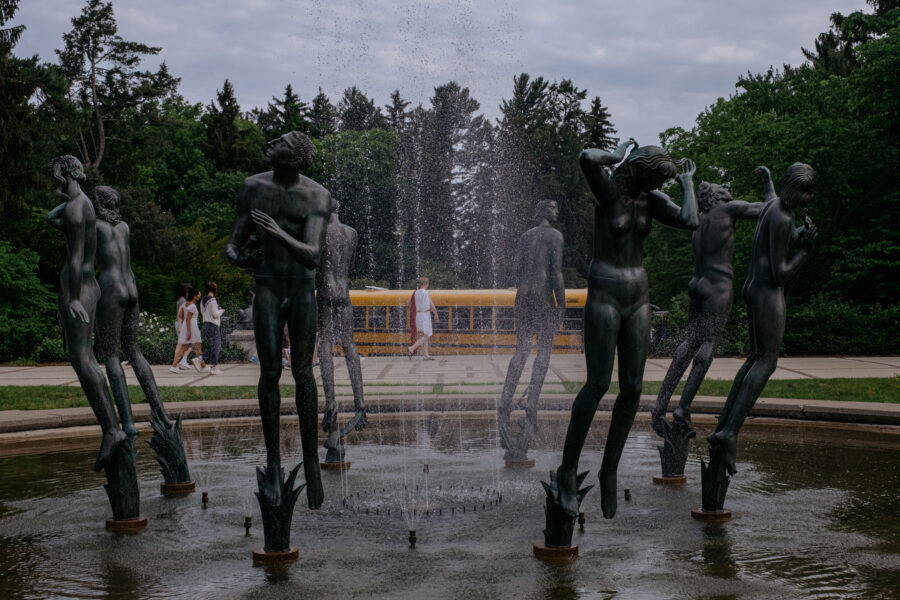
This was “‘Romney Republican’ territory, but the Republican Party has gone so far away from that,” says Mallory McMorrow, the Democrat who represents the area in the state Senate. “Even looking at the types of things Mitt Romney is proposing on the federal level right now, I think if he were still at home, he’d be a Democrat. The party has shifted so much.”
To the casual observer, this change happened overnight. But the change is less the flip of a switch than a stovetop dial cranked on high—it took a while to heat up but the pot is boiling now.
Between Barack Obama’s campaign in 2012 and Joe Biden’s in 2020, the margin of victory for Democratic presidential candidates in Oakland grew by roughly 55,000 votes. Few have noticed it, but Oakland’s share of the statewide Democratic vote now exceeds that of the city of Detroit. Oakland now accounts for roughly 1 in every 7 votes statewide. And those votes are being cast for Democrats at much higher rates than they used to be.
That’s a problem for Republicans in a state that has played a pivotal role in the last two presidential elections. But Oakland is also a national warning light for the Republicans at the highest levels of the party.
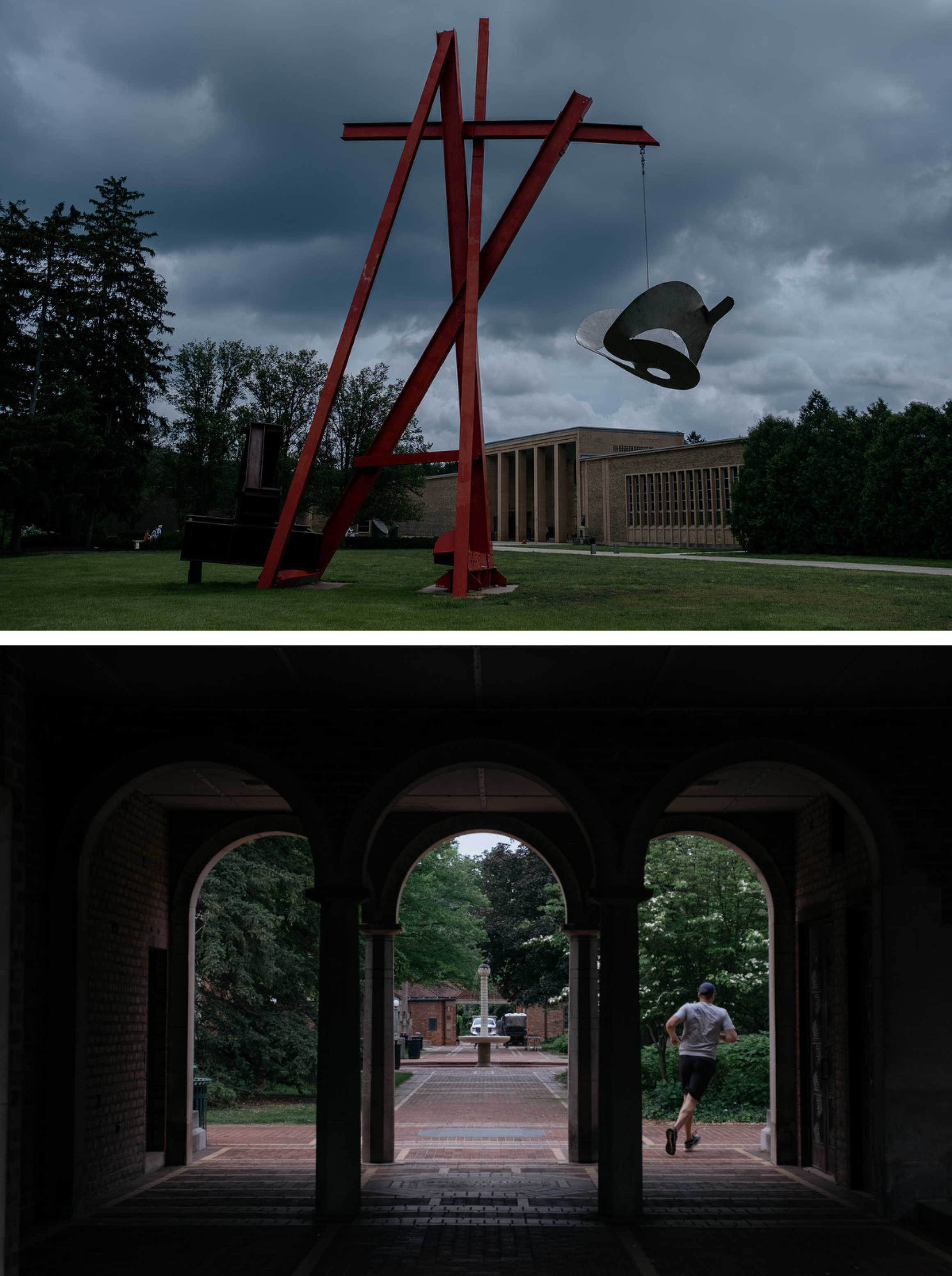
Oakland County “represents the dominant trend in the country because it combines the most affluent and college graduates in increasingly diverse suburbs becoming increasingly and emphatically Democratic,” says Stanley Greenberg, the Democratic pollster whose study of neighboring Macomb County in the mid-1980s put it on the map and elevated “Reagan Democrats” to the forefront of American politics. But that era no longer really describes the central battlefield of America’s suburban politics. Macomb can have its “Reagan Democrats”; Oakland has the “Biden Republicans.”
And there are Oakland Counties all around the nation—affluent, longtime Republican suburbs that have been trending Democratic for a long time, but where the Trump years marked a tipping point. “Look at why the Republicans are so obsessed with reversing Maricopa [County, Arizona]—but also Gwinnett [County, Georgia]—both key to Biden and Democrats winning the states and Senate,” says Greenberg.
These key suburban populations are mostly white but increasingly diverse, highly educated and relatively affluent. They aren’t scared by immigration; they support it in their own communities—especially with highly skilled immigrants, attracted to work at businesses lured to these suburbs, in many cases, by business-minded Republican politicians. They are repelled by white-grievance politics and culture-war clashes, and concerned about the rise of violent right-wing anti-government plots, like the Jan. 6 insurrection and the thwarted plan to kidnap and execute Michigan Gov. Gretchen Whitmer. They used to think of themselves as Republicans, but nowadays the GOP seems disconnected from the things they care about; it talks less about affordable child care or student debt than banning transgender student athletes or making it harder to vote. It’s the inverse of what President Ronald Reagan said in Macomb County all those years ago: They didn’t leave the Republican Party; the Republican Party left them.
In an email to POLITICO, a spokesperson for the RNC pushed back on the idea that the Republicans are having difficulties in the suburbs, pointing to GOP gains in the 2020 House elections in California, Florida and New York. The spokesperson noted surges in Republican support in, among other places, North Carolina and the Florida panhandle, and said that a plurality of registered voters in suburban Michigan “feel the socialist agenda Democrats are pushing will bankrupt the country.”
Just as the Reagan Democrats didn’t suddenly materialize with the 1980 election, the Biden Republicans didn’t spontaneously sprout up in 2020; their emergence is part of a longer story—or, more precisely, several interlocking stories.
It’s the story of how demographic trends are changing America’s suburbs, not simply in making them more diverse, but in making them more highly educated at the same time educational attainment has become a defining predictor of how Americans vote. It’s the story of how the GOP playbook—which often defaults to the tactic of demonizing cities as bastions of out-of-touch liberal elites—has missed an important shift: Suburbs aren’t at war with their cities any longer, and claiming they are has alienated potential Republican voters.
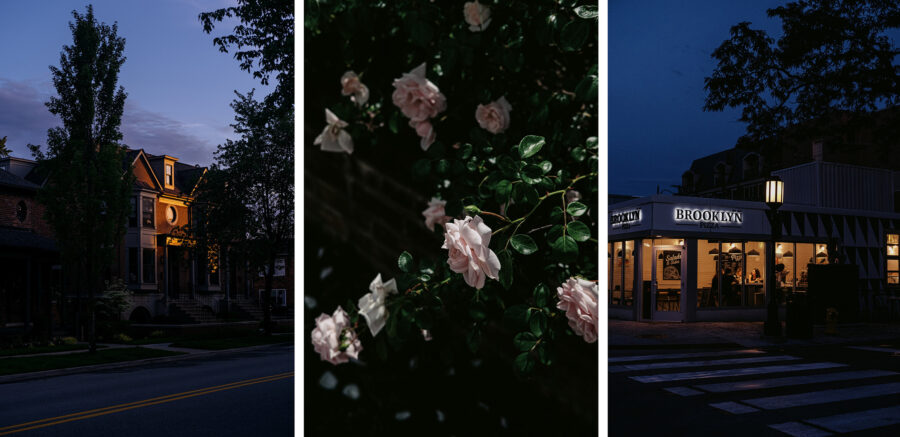
It’s the story of the Democrats who’ve remade Oakland County politics, chief among them boy wonder politician-turned-elder statesman Dave Woodward, the longtime party chair who focused on building local power cycle after cycle. And it’s the story of Democratic women, like McMorrow and Manoogian, who’ve built on that foundation with major victories in traditionally Republican areas.
It’s the story of a Republican Party in something of an identity crisis; of downballot Republicans who have found success while embracing diversity and are utterly flummoxed why the rest of the party is moving in the other direction; of the once-in-a-generation talent named L. Brooks Patterson, who made Oakland County into a Republican political behemoth first by perfecting the art of culture war, and later by trading away grievance-based politics for business-oriented conservatism only to see that traditional approach banished from the Trump-era GOP.
And, critically, it’s a warning of what happens when a political party is associated with one charismatic figurehead and doesn’t invest in candidates with their own identities; and of the strategic blunder of responding to a tidal shift of demographic change by rewriting voting rules instead of fixing a tone-deaf message.
This is the story of how Oakland County went blue—and what that tells us about the Republican Party’s continuing collapse in America’s suburbs.
L.Brooks Patterson, the man who would ultimately be credited with transforming Oakland County into a political juggernaut, arrived there as just one of hundreds of thousands of white people fleeing Detroit in the ’60s.
By that time, Oakland had already earned a reputation as a bedroom community for auto executives—most famously George Romney, the sitting governor and former head of the American Motors Corp. But that’s a bit too simplistic. Oakland was always a mix of a few distinctly different types of communities: yes, uber-wealthy enclaves for powerful people with names like Hoffa, DeLorean, Romney and Saarinen, but also inner-ring, densely populated middle- and working-class suburbs like Hazel Park, Royal Oak and Southfield; rural farming communities and small towns in the north and west; the large, diverse city and industrial center of Pontiac; and waterfront houses at the constellation of inland lakes everywhere in between.
In the 1950s and ’60s, the city of Detroit faced a battery of challenges—deindustrialization, automation, racism, the growth of car culture and the attendant investments in the interstate highway system (the new I-375 spur allowed you to drive straight into downtown Detroit from the suburbs), capital flight, disinvestment, the post-war housing boom and creation of subdivisions. Between 1950-1970, Oakland’s population catapulted from just under 400,000 residents to more than 900,000. In many instances, jobs and businesses followed. Oakland boomed, and the makeup of the county was defined both by its wealth—even if you weren’t an executive, middle-class jobs in the auto industry at the time provided quite well—and its oft-antagonistic posture towards the (increasingly Black) city of Detroit. In 1970, Oakland’s population was 96.5 percent white, but its politics were still relatively competitive; Richard Nixon carried the county in 1968 by less than 1 percentage point.
It was fertile ground for a young, ambitious attorney like Patterson to make a name for himself—and, in so doing, convert it from a GOP-leaning county to the Republican Party’s base of power in Michigan.
At the time, Patterson was an assistant prosecutor, taking the cases nobody else wanted, like that of a 30-something Pontiac woman named Irene McCabe who complained that a shopkeeper near her daughter’s elementary school was selling lewd magazines to kids. When Patterson’s more senior colleagues declined the case, it fell to him. He pursued it doggedly and got jailtime for the shopkeeper. But dogged as he was, Patterson had an impolitic way of telling people what he really thought. Which is why, in January 1971, shortly after his 32nd birthday, he was fired after publicly criticizing a sitting judge for a lenient sentence.
Out of a job and looking for steady work in private practice, Patterson heard from Irene McCabe, who had a project that could use some legal advice: a group of mostly white parents in Pontiac who wanted to stop busing, which was quickly shaping up as the hottest culture-war issue in America. They called themselves the Northside Action Group, and soon after became known as the National Action Group, or NAG.
Two years before, Black parents in Pontiac, Michigan, had filed suit, alleging that the school district in Oakland’s diverse-but-segregated county seat drew zones with the “purpose and/or effect” of creating separate schools for Black children. In 1970, a U.S. District Court judge found in favor of the plaintiffs, ruling that Pontiac used the “neighborhood school concept as a disguise for the furtherance or perpetuation of racial discrimination.” In short, Pontiac would have to start busing its students to achieve racial integration.
The ruling was a thunderclap. “This was a real alarm for a lot of northern cities,” says Matthew Delmont, a Dartmouth historian and author of Why Busing Failed. “Now that they see a court actually order it, it seems like dominoes might start falling: You might see Chicago, Los Angeles, New York, Boston and other places having to actually comply with court orders.”

With NAG, Patterson had found the perfect vehicle to drive media attention on a hot-button issue and to establish himself politically. They filed lawsuits and held marches, mothers chained themselves to the gate at the bus yard, parents kept their kids home during population-count days to deprive the district of funding. They dominated news coverage—locally, first, then nationally. In the spring of 1972, they staged a weekslong march from Oakland to Washington, D.C. Almost always, it would be Irene McCabe at the forefront, and Patterson quoted further down in the story.
The setup allowed Patterson to tie himself to NAG’s most popular successes while remaining at a remove in case he needed to distance himself from the anti-busing movement’s most repulsive excesses, as when, on the balmy night of August 30, 1971, just before the start of the schoolyear, a group of Klansmen firebombed 10 Pontiac schoolbuses. Patterson was quick to issue a statement. “Let me emphasize that NAG members always choose to work within the law,” he told reporters. “We don’t do that by blowing up buses.”
Later that week, Pontiac began busing its students. It could’ve been the end of Patterson—NAG had lost its fight, and even a whiff of Klan-related violence was a pestilence on the anti-busing movement. But then something happened that changed NAG’s trajectory.
In September 1971, U.S. District Judge Stephen Roth mandated cross-district busing not just in one city in metro Detroit, but across 8 Mile Road, the Mason-Dixon line splitting city and suburb. Black kids from Detroit could be bused to white suburbs in Macomb, Oakland and Wayne Counties; white suburban kids could be bused into predominantly Black Detroit schools. A major legal setback became a huge political gift, pouring jet fuel on the sense of white suburban grievance.
“All of a sudden, I wasn’t in a lonely position any more,” Patterson told the Free Press years later. “Instead of having [the] backing of, as someone once put it, ‘85,000 rednecks in Pontiac,’ four million people in three counties were upset about busing.” Come November, Patterson trounced Tom Plunkett, the Democratic incumbent who had fired him less than two years earlier, in the race for county prosecutor.
In office, Patterson continued his NAG-style media stunts—waging war against “welfare fraud” with sting operations, cracking down on pornography and personally arbitrating obscenity disputes by watching films such as “The Last Tango In Paris.” Most notoriously, Patterson made himself the voice of suburban opposition to Detroit and its first Black mayor, Coleman Young—a man who shared Patterson’s gift for weaponizing words to get attention. Their battle wore on to both men’s political benefit—“city vs. suburb” and “Black vs. white” played well on both sides of 8 Mile Road—even as it effectively snuffed out any hope of regionalism for decades. Patterson’s success came from “noting what makes people sick and then appearing on TV to proclaim that he is sicker about it than they are,” Free Press columnist Jim Fitzgerald wrote in 1977. “If Brooks took the Pepsi test, he would vomit after sipping the Coke.”
As the years rolled on, Patterson won reelection over and over—1976, 1980, 1984. He tried for U.S. Senate in 1978 and lost the GOP primary. He tried for governor in 1982, and again lost the primary. As a consolation, he was handed the nomination for attorney general, but lost in November. Asked about a potential run for lieutenant governor, he declined: “I would rather crawl across I-75 on my knees on cut glass at rush hour.”
By the mid-to-late 1980s, it’s not that Patterson’s electoral career was sputtering—he could have stayed prosecutor for life—so much as he kept bumping up against the ceiling often faced by culture-warriors: There was a limit to what outrage could get you. Increasingly, grievance was disconnected from the comfortable realities of life for so many people in Oakland.
In the 1980s, as Detroit struggled amid a wave of crime, substance abuse and population decline, Oakland County was an unadulterated success, and attracted those people and businesses with the means to move out of the city. Large numbers of Black middle-class Detroiters relocated to Southfield, a comfortable city just across 8 Mile. The Detroit Lions moved to the Pontiac Silverdome in the ’70s; the Pistons followed suit, moving first to the Silverdome, then, in the ’80s, into the brand-new Palace of Auburn Hills; nearby, construction was underway for Chrysler’s new world headquarters, topped by a glass atrium shaped like the company’s iconic pentastar logo.
Oakland wasn’t just a suburb; it had swagger. Lee Iacocca of Bloomfield Hills was the CEO of Chrysler and author of the best-selling nonfiction book on the planet. Playing at the Palace, the “Bad Boys”-era Pistons were back-to-back NBA champions. Madonna, a native of Rochester, was the undisputed queen of pop who shared Patterson’s penchant for stoking outrage.
And Patterson had that swagger, too. No one called him Mr. Patterson; he was “Brooks,” a mononym, like Elvis or Cher.
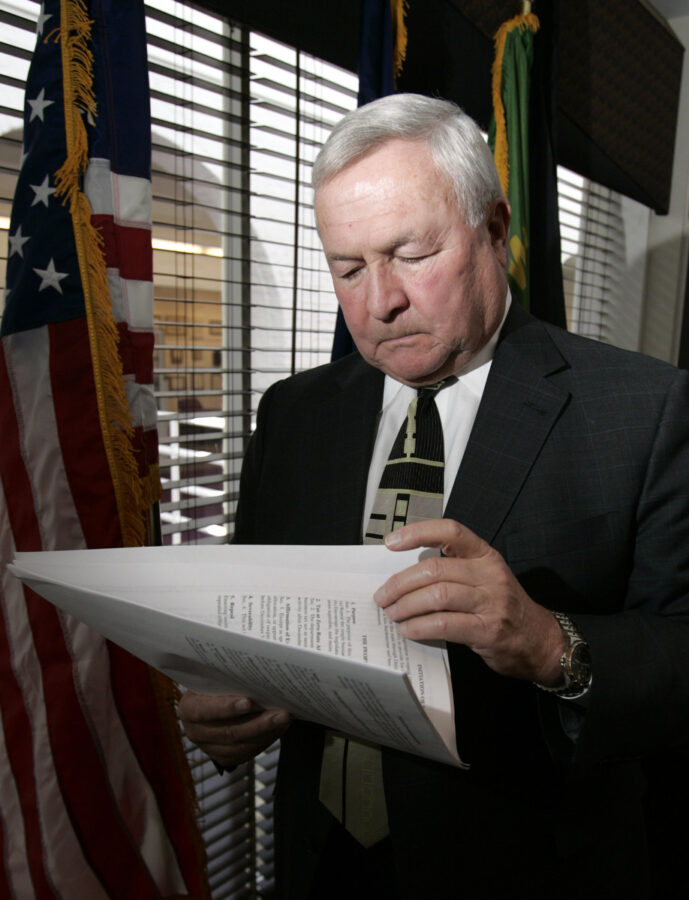
“There’s never been another individual, I would say, in Michigan politics like him,” says state Sen. Jim Runestad, an Oakland Republican. “I’d be in a room of 200, 300 people, and we’re talking and having drinks or something, and all of a sudden, there’d be a change in the room. You could see the change. Then somebody’d say, ‘Brooks just came in.’ I’ve never met another person like that—that kind of charisma, where just entering a room, even though you couldn’t see them, you felt that presence, that excitement.”
To those who loved him, he was a man of Falstaffian appetites in food and whisky who presided over an incredible amount of economic and population growth, kept taxes low, quality of life high and was almost Steve Jobsian in his ability to market the county. To those who hated him—and there were just as many—he was a big city machine boss transplanted to the suburbs who made it big by poking bruises on the body politic, then prescribing himself as the antidote. He somehow managed to get away with saying outlandishly offensive things because, well, when you’re living in one of the wealthiest counties in America, as long as life is more or less OK, you’ll put up with a lot.
But Patterson wanted more than what he had. In 1988, he co-chaired George H.W. Bush’s presidential campaign in Michigan (Bush walloped Michael Dukakis by nearly 8 points) and opted not to run for reelection as prosecutor. Then, heading into the 1992 election cycle, Oakland County Executive Daniel T. Murphy—the only man ever to hold the office since it was created in the 1970s, an inoffensive and low-key presence despite being the other GOP goliath in the county—announced his retirement. The top job was Patterson’s for the taking.
The thing was—and Patterson didn’t yet realize this—being the CEO of a county required a different skillset than he was used to. It centered on oft-quotidien concerns about budgets, pension funds, county parks and economic development. It didn’t lend itself to culture-war fights. Asked about his propensity to be a bomb-thrower in the run-up to his 1992 campaign, Patterson declined to endorse nonproliferation: “One man’s bomb is another’s factual statement.” But you couldn’t really wage a war if the other combatant laid down his arms.
On June 23, 1993, six months into Patterson’s first term as executive, Coleman Young announced he would not seek a sixth term that November. For Brooks, it was a turning point. The Detroit-vs.-suburbs stuff just wouldn’t play the same with the new mayor, Dennis Archer, a low-key former state Supreme Court justice and central player in metro Detroit’s legal scene. And so Patterson downshifted his own public persona to fit the time.
“I have opinions on social issues, but I don’t represent us on social issues,” Patterson told Crain’s Detroit Business a few years later. “I did that as a prosecutor. My job now is to be an ambassador, a promoter for what’s good about Oakland County.”
Brooks played the role with vim. The pitbull prosecutor turned happy warrior fighting on behalf of business conservatism.
He instituted a two-year rolling budget that made it easier for the government to weather economic downturns. The fiscal stability, in turn, earned the county a coveted AAA bond rating, which made it cheaper to borrow money and, thus, easier to make needed investments.
He leveraged the area’s massive engineering and manufacturing sector to found “Automation Alley,” a successful effort to attract young college graduates and skilled workers and the businesses that rely on them. The effort came to encompass all of metro Detroit. He created Medical Main Street to focus on growing the health care and life science industries, and an Emerging Sectors Initiative to bring more high-tech businesses to Oakland County, an effort that resulted in more than $5 billion in new investment and tens of thousands of high-skilled jobs, many of them filled by foreign-born workers.
Oakland County was roaring. But it was also starting to change. In 1992, Bush carried the county, but with only a plurality. It would be the last time a Republican presidential candidate won Oakland; in the same years that Oakland reelected Patterson—1996, 2000, 2004 and so on—Democrats carried it. It was a trend that would soon be felt downticket.
Patterson had been attracting investment from all over the world, bringing in new immigrants and college graduates. It was all going according to plan. But there was one thing he perhaps hadn’t planned for: How all these new people might vote.
In 1998, when Dave Woodward was elected to the state House at age 22, one of the things that immediately separated him from other young win-it-now political obsessives was his patience. He saw a trend: Bill Clinton had won Oakland County in 1996, the first Democrat to carry it in decades. If they could just convince those people to vote Democratic lower on the ballot, that could change everything.
Having grown up in Oakland during the ’80s and ’90s, Dave knew the county’s reputation as a place for the wealthy and well-connected. He also knew that it bore little resemblance to the lives of many people in the county—himself included. “In Oakland County, particularly, prosperity—in so many ways—is all around you,” he says. “The opulence is all around you.”
Born and raised in Royal Oak, one of the middle-class, inner-ring suburbs in the south end of the county, his family was neither wealthy nor well-connected. His dad worked retail at Sears for 25 years—a working-class living that put food on the table but wasn’t the kind of money that created feather-bed comfort. Woodward’s interest in politics started in high school, but when it came time for college, he needed to be practical: At Wayne State, he set himself up for a career as an actuary. But being an actuary didn’t excite him—not like politics. In 1998, Woodward ran for the open seat being vacated by his hometown state representative, a Democrat. Woodward didn’t have a whole lot of money or connections and Royal Oak was still a battleground with lots of moderate Republicans—and the year was otherwise miserable for Michigan Democrats—but he won anyway, with nearly 55 percent of the vote.
He arrived in Lansing, 22 and impossibly boyish-looking, as the youngest member of the minority party. And though he threw himself into constituent services and bread-and-butter issues like clean water and consumer protection, he quickly found that minority status imposed limits on what you could achieve through hard work alone. Still, he believed the rah-rah attitude of his more experienced fellow legislators who vowed to take back the House in 2000.
“And right after that didn’t happen, I and a group of people sat down to say, ‘All right, we’ve got to map this out,’” remembers Woodward.
On paper, they sketched out a 10-year plan to build the Democratic Party in Oakland County. At the time, the county party was more a loose confederation of local groups and elected officials’ campaigns than anything resembling a coherent organization.
“We had to build everything from scratch,” says Woodward.
He started by identifying local races where they stood a chance of making gains. Initially, the model for this calculation was crude. “It was like, ‘Where was the margin of loss less than 10 percent? Let’s start there,” Woodward laughs.
“I’ll be honest, there were some folks who got mad at me because we didn’t help everybody in the same way,” he says. “But this was about winning! It’s about winning elections and then winning majorities so that we can actually govern. … The goal, for me, is not just to compete in an election for the sake of an election; it’s what you do with the power once you have it.”
To start, that meant finding voters. Woodward knew Democrats existed in Oakland—Bill Clinton won in there 1996 and Al Gore in 2000, which, in retrospect, were early signs of a national shift in the political preferences of college graduates—but he also knew that those voters either tended not to vote in down-ballot races, or split their tickets.
“It’s all so high-tech now, the modeling and all that type of stuff,” says Woodward. “This was old-school: I needed to find us 5,000 more Democrats. So we’re going door-to-door and asking, ‘Are you a Democrat?’ We found them. And we built a database and made certain to put energy and resources into making sure that everyone we identified a year-and-a-half out from the election ended up voting. … It’s not rocket science. It was like, ‘This person should be voting with us, but just hasn’t.’”
In November 2002, Woodward won his third term in the state House—his final one, thanks to term limits. At 26, talk naturally turned to what he wanted to do next. In Oakland, Democrats made gains, but the hole was deep: Republicans had a 19-6 supermajority on the county board.
Woodward had attended one of those 19-6 county board meetings, and remembers speaking afterwards with Dave Coulter, a Ferndale Democrat elected to the board in 2002.
“That was my first elected office, so I was a bit crestfallen to see how little you can really get done in a minority that small,” says Coulter. He had worked to build collegial, productive relationships with the Republicans on the commission—and with Patterson himself, for that matter. But it wasn’t enough to actually manifest the change he wanted to see.
Woodward was offering to help. “I’m like, ‘OK, clearly we need some more Democrats elected,’” Woodward laughs. “He’s like, ‘Ya think?!’”
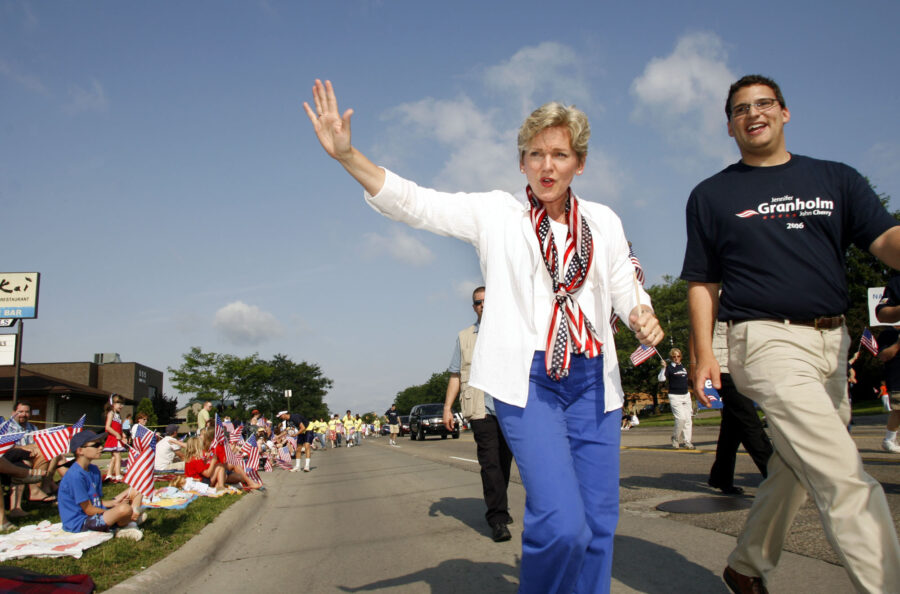
In the process of recruiting candidates, the tables turned on Woodward: Dave, you’re term-limited. Why don’t you run?
It was not exactly advisable for a rising star to leave the legislature to pursue lower office, running in a seat where he’d face a Republican incumbent whom Patterson was grooming to be the next chairman of the board. Plus, he would still be in the minority. But that was where his work was: turning Oakland blue.
In November 2004, Woodward upset the Republican incumbent. Several of his recruits won, too. The Republican majority shrunk from 19-6 to 15-10. Now it was time to slam on the accelerator. Woodward and Coulter came up with a new plan.
“For the next six years that I was [on the board], we sort of divided up responsibilities,” Coulter says. “He oversaw the ‘political’ side of things [for the Democrats], and I sort of oversaw the ‘caucus management’ and ‘negotiating with [Patterson]’ side of things. And that worked for us. … I would try to raise issues and policies, and then Dave would try to translate those into votes.”
They picked issues designed to contrast with Patterson’s Republicans, like transit, clean water, urban redevelopment and making sure middle-class areas weren’t neglected in favor of wealthier communities.
“It was a combination of raising issues that were emerging … and then getting candidates who were credible,” says Coulter.
“It’s not just a winning formula; these are things that the voters want,” says Woodward.
Patterson saw Democrats making gains and it perturbed him. But he understood the cause of it earlier than most in his party. “I’ve said all along that the far-right wing of the [GOP] has done a very effective job of running moderate women out of the party,” he told the Free Press in 2004.
But what Patterson might not have expected was that Woodward had his eyes on something that Republicans had taken for granted as theirs to control: redistricting.
•••
It was a quirk of Michigan law: The state legislature controlled the once-in-a-decade redistricting process for federal and state legislative maps. New county commission lines, however, were decided by a panel made up of five people: the chairs of the county’s Democratic and Republican Parties, the county clerk, treasurer and prosecutor.
After the 2006 election, the Republican majority on the board was just 13-12. Whoever controlled the district lines after the 2010 census would likely determine the majority. All of the countywide posts would be up in 2008—a presidential year, which meant high turnout for Democrats—and one of those offices, Patterson’s old job of county prosecutor, was an open seat. In November, Barack Obama carried Oakland with 56.5 percent of the vote. Patterson won a fifth term as county executive with 58 percent of the vote. Republicans held the clerk’s office, but Democrats picked up the treasurer and prosecutor posts—which meant they would control redistricting in the county for the first time in generations. Woodward would get his majority. It was all going according to plan.
But there was one thing Woodward hadn’t planned for: Patterson’s sway in the state capital.
At Patterson’s behest, the GOP state legislature rewrote the rules of county redistricting to strip control from the five-member bipartisan panel and hand it to the GOP-controlled county board. And lest there be any doubt about why this was happening, the new law was written in such a manner that it applied only to Oakland County—only to counties with a population of more than 1 million (there are two: Wayne and Oakland) that didn’t operate by their own charter (just Oakland).
“Brooks came [to Lansing] and said, ‘Hey, make this exception for Oakland County,’” one top Michigan Republican strategist who was involved in the episode told me. “He wanted the board. When he was exec, it was more like they weren’t an independently elected board; even though they were, Brooks ran them. He gave them their agenda. … They did what Brooks wanted. He ran that county like a king. He wanted a compliant board. That mattered more to him than [them being] Republicans, quite honestly.”
Republican Gov. Rick Snyder signed the bill into law in December 2011.
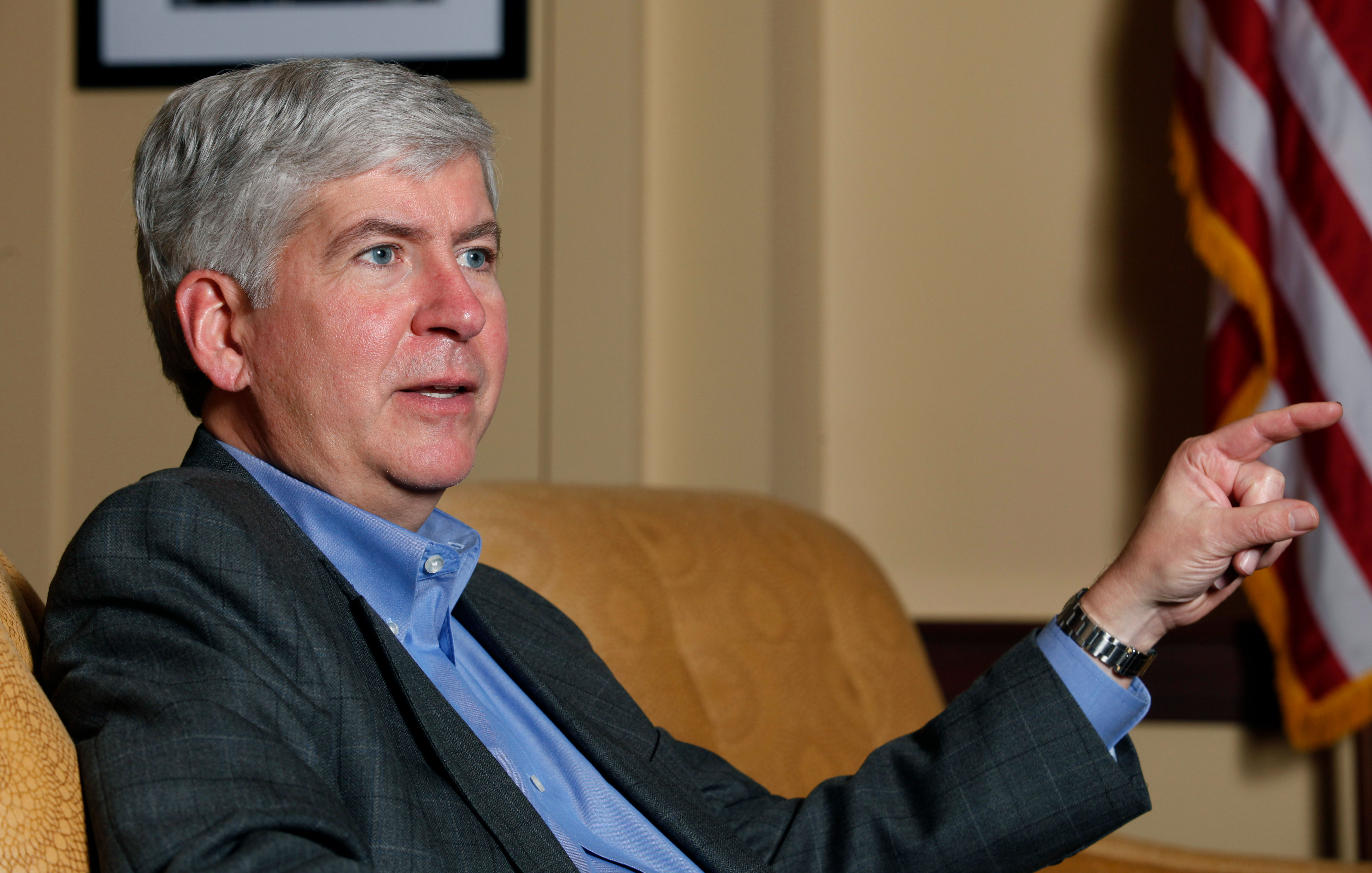
“I’ve been involved in Michigan gerryma— er, redistricting for 30 years,” says the GOP strategist, who was granted anonymity to speak candidly. “They came to me and had me help them draw the maps that they actually passed in Oakland County.”
The new lines were an extraordinary gerrymander, turning a 25-seat commission with a narrow GOP majority into a 21-seat commission with a 14-7 GOP majority.
“This is how Republicans play. You see it playing out with the voting laws around the country,” says Woodward, still angry about it a decade later. “They held onto their power an extra decade longer than they probably would have otherwise.”
The Democrats had to begin all over. This time, they wouldn’t be starting from scratch. The commission seats hadn’t flipped yet, the voters themselves already were.
Oakland’s population was increasingly diverse and highly educated, with people drawn by the economic opportunities that Patterson himself had championed. Between 1990 and 2010, the portion of Oakland’s population comprised by people of color had more than doubled; almost 55 percent of its residents had at least an associate’s degree. By 2014, more than 1 in 10 of Oakland’s 1.2 million residents were foreign-born. For Republicans, it was a demographic time bomb.
And it ticked down just as the Republican Party—nationally and locally—was about to be taken over by someone whose politics were uniquely tailored to turn off people with college degrees, people in diverse and well-to-do suburbs, people who had immigrated to the country; someone who would make it radically easier for Democrats to recruit donors, volunteers and voters from those same groups; someone who would replace Brooks Patterson as the Republican Party’s indispensable man—just as he did with local Republican power-brokers throughout the country: Donald J. Trump.
For a long time, the operating assumption in places like Birmingham, Bloomfield and Troy wasn’t simply that someone like Mallory McMorrow couldn’t win an election, it’s that she shouldn’t waste her time trying. It was too much of a reach—a GOP-friendly electorate in a seat drawn by Republicans and held by an incumbent, Marty Knollenberg, whose dad had been a longtime congressman.
But the election of Donald Trump challenged many operating assumptions about politics and the communities in which we live. Being an outsider could be an advantage.
McMorrow grew up in New Jersey, moved around the country, and came to Michigan to settle down with her husband, who grew up in Birmingham. (Full disclosure: Her husband and I were students at Michigan State together, and blogged together for a year or two circa 2005.) Though McMorrow is an educated, accomplished young professional, running for office in the Detroit suburbs isn’t what you expect of a career that includes a stint at Gawker, the gossipy blogging conglomerate.
In 2016, “a lot of women just sort of admitted, like, ‘I’ve been comfortable for way too long and I haven’t paid attention to what’s going on. And now I am. And what’s happening is bullshit, frankly, and I’m in a position to make a difference,’” says McMorrow. “I had no idea what I was doing. But I knew, ‘OK, if this guy can become president, we need to put better people in place.’”
Not long after Election Day 2016, a video went viral showing a group of white students at a middle school in Oakland chanting “build that wall” in the cafeteria as a few Latino students cried or left the room. It was the same school where McMorrow and her husband had voted for Hillary Clinton just days before.
“That was heartbreaking. And I distinctly remember, like, Googling ‘how to run for office.’” says McMorrow. She jumped into the race for state Senate.
“Nobody thought I had a chance. I sat down with some local Democratic Party leaders who flat-out told me, ‘You’re going to get destroyed, but you can build your name recognition and run for city council next time.’” says McMorrow.
McMorrow’s district had a history as a high-profile, expensive disappointment for Democrats. In 2006, now-Congressman Andy Levin ran for a largely-similar state Senate seat in a race that cost $2 million and which he lost narrowly, because even in a Democratic year, Oakland hadn’t changed enough for the national wave to matter.
But the landscape had shifted. Due in large part to the economic growth in high-tech and emerging industries in Oakland County, Troy, a suburban city of just over 80,000, experienced a boom in college-educated Asian American and South Asian residents. In 2000, AAPI people comprised roughly 13 percent of Troy’s population; the Census Bureau now estimates they make up 25 percent. Roughly one in four of the city’s residents is foreign-born. Trumpian white grievance politics did not speak to them. (In the 2020 election, the city accounted for 1 percent of the statewide Democratic voteshare—it is now as vote-rich for Democrats as the blue stronghold of Flint.)
But it’s not simply that diversity brought in new voters, diluting the strength of the Republican electorate. The new diversity actually affected the political preferences of the mostly white residents who already lived there. Republicans became less Republican.

“The reality is that I still represent an 80-plus percent white district. But there is a not-insignificant representation of AAPI residents, of Muslims, of Jews,” says McMorrow. “There is enough diversity … that even if you are a straight, white, Christian person who lives in Oakland County, you don’t want to demonize somebody who’s an immigrant, because they live next door to you and you work with them. … I think that’s the difference: I don’t think my constituents see diversity as a threat.”
It also blunted the effectiveness of Republican attacks on McMorrow for having only recently moved to the district. McMorrow remembers going door to door in Troy and encountering a woman who’d received a mailer that posed her, via photoshop, next to the “Hollywood” sign. “She was like, ‘Why did I get this thing about you being from California?’ I told her: I’ve lived in five different states, my husband is from here, here’s why I moved to Michigan—gave her the whole spiel—and she finally said, ‘You remind me a lot of my daughter who moved to Chicago. Can you bring her back?’” says McMorrow. “That was a lightbulb moment for us: There are so many people in Oakland County who want their kids to either stay here or to move back.”
For years, Michigan has hemorrhaged college graduates to big coastal cities—New York, Washington, Chicago. In some ways, this “brain drain” is a byproduct of the lack of regional cooperation that has long plagued metro Detroit, preventing it from investing in things that young professionals value, like mass transit or dense, culturally rich, walkable cities.
Patterson and other suburban politicians had long made hay out of fanning a city-vs.-suburbs narrative, but that approach has lost its effectiveness. Now, says McMorrow, Oakland residents realize “that our proximity to Detroit is an asset.” The generation of white people who’d fled to the suburbs in the 1950s and ’60s is an ever-decreasing share of the population, and their descendants often have affection for Detroit and value diversity.
“The shift—it wasn’t even that you could see it in the numbers afterward; like, you could feel the energy shifting on the ground beneath your feet,” says Mari Manoogian, who ran for state House alongside McMorrow in the 2018 cycle (McMorrow’s Senate district encompasses a major chunk of Manoogian’s seat).
Manoogian grew up and still lives in Birmingham, a posh town about eight miles up Woodward Avenue from 8 Mile Road. It’s one of the wealthiest communities in the state, which made her an outlier: Her father worked his way up from the bucket-truck brigade with Detroit Edison to become a poobah in the National Utility Workers’ Union. For class projects in school, young Mari chose subjects she knew her well-heeled classmates wouldn’t, profiling labor icons like Samuel Gompers and Cesar Chavez—“people I figured nobody else would pick … because that’s not the type of community we’re from.” She remembers being “chastised for having an Obama sticker on my Jeep in 2008,” when she was a junior at Birmingham’s Seaholm High School. “Fast-forward 10 years later, and I’ve got kids from Seaholm knocking doors for me.”

While some of that is about increasing diversity, the change in Birmingham is less about demography than the rise of so-called “Biden Republicans.”
“The ‘Oakland Hills Country Club set’ is changing, or at least having some serious reservations about the current version of the Republican Party,” says Manoogian. “Knocking doors in 2018, … people would say, ‘I’ve voted Republican my whole life, but I’m not voting Republican anymore. … They’re not focused on the issues that matter to us. They’re focused on these culture-war issues.’”
McMorrow sees it, too. “Democrats used to get hit on for ‘social justice’ issues. I think the Republican Party is on the flip side of that now,” she says. “It’s like, ‘I’m a small business owner …’ or ‘I’m an executive, and I’ve always had a comfortable tax structure. But I don’t care if a transgender girl wants to play soccer. Let her play soccer!’”
In places like Oakland, the Republican Party’s continuing focus on culture-war issues even puzzles former Republican officeholders.
“It’s the opposite of a big-tent party right now,” says Martin Howrylak, a Republican who represented Troy in the state House from 2012-2018. “That was really the game plan of Trump: to create lines: ‘You’re either with me or against me. And if you’re not with me, you might as well—politically speaking—die.’ And that ‘take no prisoners’ approach is the antithesis of what’s needed here. As long as the party continues to embrace the former president, it’s going to have trouble in Oakland County.”
That’s not to say that every Oakland Republican is in trouble. Some have adapted masterfully to the changing demographic and political realities.
When Republican Jim Runestad jumped from state House to Senate in 2018, he suddenly faced a district roughly three times larger—and substantially more diverse—than the one he was used to. The city of Novi, which he represents, has, like Troy, had a massive infusion of South Asian residents. Runestad refused to write-off those voters.
“I immediately went to all the events I could possibly attend. I was at a Bollywood dance-off,” Runestad says. “I was at a Temple event. I was at India Day. I was at so many functions, and all of them that I went to—just about every case—they said, ‘You’re the only Republican who’s ever been here.’”
It mystifies him that his fellow Republicans ignore these voters.

“The thing that upsets me the most is that that outreach has not been done all along,” says Runestad. “They love this country. They don’t want lots of regulation. They work very hard on their businesses. They don’t want tremendous taxation. They want police presence. Talk to individuals in the Asian community: Are they for ‘defund the police’? Absolutely not. … They go, ‘You’re right. About 90 percent of everything we believe is Republican, but the Republicans have not shown up.’ You can’t neglect an entire community … and expect their support.”
If the Republican Party had made the same switch Patterson once did, trading in culture wars for a business-conservative approach, 2018 and 2020 might’ve played out differently. But in Oakland, as in communities throughout the nation, Trump became the alpha and omega; there was no Republican Party separate from him—which was good for him, but very bad for suburban Republicans, as Oakland was about to show.
In November 2018, McMorrow ousted the GOP incumbent in a seat drawn as safely Republican a decade earlier. Manoogian won her state House race by about 16 points. Oakland County’s two Republican-held congressional districts flipped with the elections of Elissa Slotkin and Haley Stevens. Gretchen Whitmer, the granddaughter of the Pontiac schools superintendent during the busing crisis, carried Oakland with 347,080 votes—more than any Republican presidential or gubernatorial candidate had ever won, and more than Hillary Clinton had received there in 2016.
But more alarming for many Oakland Republicans was what happened at the county level. Ever since Patterson took control of redistricting and engineered a 14-7 Republican board, Woodward’s Democrats had picked up seats, cycle by cycle. In 2018, he finally won his majority: 11 Democrats, 10 Republicans.
But the twist of the knife—Woodward’s poetic coup de grace—came in how he flipped the seat that gave them control. Novi, which had never elected a Democrat before, voted in a new commissioner—someone who had known Brooks Patterson most of her life, whose father occasionally campaigned with him; someone who was a high-school senior in Pontiac all those years ago when Patterson led NAG, and graduated two months before the schoolbuses were firebombed; someone Woodward encouraged to run; someone who had considered herself a Republican until, she says, the party left her: Gwen Markham, daughter of Daniel T. Murphy, Patterson’s Republican predecessor as county executive.

“There is an irony to it for sure, because my sensibilities, I don’t think, are all that different from what they were when I was 20 and a moderate Republican,” says Markham. “I still believe in good fiscal policy: give the taxpayers good [programs] and don’t waste their money. But I also believe that climate change is real and we have a responsibility to fix the planet—and I’ve … always believed that women should have control of our own bodies.”
She doesn’t see space for people like her in today’s Republican Party, which is dominated by Trump and disconnected from the issues that resonate in the lives of many suburbanite ex-Republicans.
“That ‘Biden Republican’ exists, and they call themselves that—out here, they do,” Markham says. “They were pretty comfortable … but they kind of woke up and went, ‘Holy crap, this is not the future that I want for my kids.’ A lot of these new folks—doctors, lawyers, young people—[are] coming to us and saying, ‘The Republican Party doesn’t represent us.’ That’s how I ended up being a Democrat.”
•••
In March 2019, Patterson got the diagnosis: stage-4 pancreatic cancer. It moved fast, and five months later, on August 3, 2019, he died at home at age 80, surrounded by his family.
The commission would decide who filled out the rest of Patterson’s term—effectively, who would enter the 2020 cycle as the incumbent. Woodward briefly put himself forward as a candidate, but after a whirlwind of vote-counting, realized he didn’t have the support: He’d need to vacate his seat for the appointment, which would deadlock the board, 10-10. He needed a consensus candidate Democrats could agree on.
He knew just the man: Dave Coulter, Woodward’s onetime partner on the commission, the man who had helped him build the county board’s Democratic majority one voter at a time.
Since stepping away from the board years ago to run for mayor of Ferndale, Coulter had gained a reputation as a capable executive and progressive able to work with business interests. Patterson thought highly of him. On August 16, Coulter was elected to fill out the remainder of Patterson’s term. The bulldog prosecutor-turned-executive known to inflame city-suburb tensions was replaced by a pro-regionalism, pro-transit Democrat who became the first openly gay man in Michigan to serve as a county executive.
Without Patterson to temper its tone, the Republican Party in Oakland, like local Republican parties in communities throughout the country, became more Trumpy.
Nowhere is this more apparent than in the rise of Meshawn Maddock, an Oakland woman who co-founded Michigan Trump Republicans, sat on the executive board of the Oakland County GOP, and chaired the party organization in the Oakland-based 11th congressional district.
In August 2020, Maddock and Manoogian appeared on Fox 2 Detroit’s “Let It Rip,” a “Crossfire”-style news segment. Amid a wave of protests throughout the country after the killing of George Floyd, Maddock used the TV hit to make the case for Trump.
“I can tell you, as a woman: Women want law and order. We want law and order in our businesses, in our homes, in our families,” said Maddock. “That’s not something the Democrats can offer right now. It’s chaos, destruction, looting and burning.”
Fox 2 host Charlie Langton gave Manoogian a chance to respond. “I was just in downtown Birmingham last night, and I didn’t see any chaos, destruction, looting and burning,” Manoogian said. “We’re represented by Democrats here just fine.”
“I’m sorry, Charlie,” Maddock shot back. “That we would use Birmingham, Michigan—which is the bastion of elitists—I mean, that’s a bunch of rich white women, and that’s what she’s using as an example?”
“They’re voters,” said Langton, looking confused.
“Look at Portland, Chicago—those are the Democrats’ strongholds. Those cities have been brought to their knees by leftist ideology, by Democrats. That’s being ignored. Nobody really is interested on Election Day by how safe Birmingham, Michigan is.”
It wasn’t just that Maddock was arguing this point, it was the way she argued it: By alienating the women of Birmingham, a community that had been a GOP stronghold until recently, and by alienating women elsewhere in Oakland who identified with Birmingham’s “rich white women.” Maddock was proud enough of the exchange to post it on her own Facebook page.
A few months later, Maddock and her husband, State Rep. Matt Maddock, helped organize buses to take Trump supporters from Oakland County to the Jan. 6 Trump rally-turned-insurrection at the U.S. Capitol. One month later, she was elected co-chair of the Michigan GOP. This week, she attended a rally in Lansing, calling for an audit of the 2020 election results.
“People like Matt and Meshawn Maddock are the powers in the Republican Party—not just in Oakland County, but in Michigan,” says Timmer, the former executive director of the state GOP. “They are the most powerful Republicans in the state.”
The dynamic puzzles Democrats because it seems clear what Republicans could do to compete in places like Birmingham, Bloomfield, Novi and Troy.
“I don’t want to tell my potential opponents how to beat me, but I think that if [Republicans] did stay more Romney-esque, it would still be a Republican stronghold,” says McMorrow, who is up for reelection in 2022. “But it just feels like Ronna [Romney McDaniel] and company have dictated that this is the culture of this party, all the way down to the local level. And I just don’t think that works.”
In November, Manoogian won reelection with 58 percent of the vote. Coulter won a full four-year term as county executive. Gwen Markham was reelected to the county commission, and so was Dave Woodward, who now chairs an 11-10 Democratic majority. Joe Biden carried the county with 434,148 votes—defeating Trump by a margin of victory of nearly 110,000.
Once the 2020 Census numbers are released, statewide redistricting of congressional and legislative maps will be done by a nonpartisan board for the first time after several cycles of GOP control. And in Oakland, the law Patterson hastily passed to take power from the five-person districting panel and give it to the board means that Woodward will be drawing the lines this time around. “Talk about payback,” he says, laughing.

Meanwhile, the Republican Party hasn’t done an autopsy of an election in which it lost the White House and Senate, two years after an election in which it lost the House. Of course, it’s hard to do an autopsy of an election you lost without first admitting that the election was lost, not stolen. Such a post-mortem would likely reveal that the party’s disinterest in holding onto the suburbs prevents the rise of new Pattersonian Republicans with their own identities separate from Trumpism and that this will have long-term historical consequences.
“There are dozens, if not hundreds of these local or regional-level political power brokers who shape the outcomes of how our cities and regions function in ways that just aren’t visible to most people,” says Delmont, the Dartmouth historian. “We spend so much time talking about who’s in the White House or even who’s in Congress. But it might be the L. Brooks Pattersons of the world who actually determine, like: Do we have affordable housing? Do we have segregated cities? Do we have police forces that are militarized? The people who actually operate the levers of power are probably much more positioned like a Brooks Patterson than a President Trump or President Biden.”
It also accrues to the benefit of people like Dave Woodward.
“In 2018, we saw record turnout. In 2020, there was even more record turnout,” Woodward says. “If we can sustain that for, I mean, one more cycle, you’ve got a lifetime voter in the making. And it’s going to make it harder and harder for the Republican Party to win elections.”
“What’s the future of politics in places like Oakland County?” I asked Mari Manoogian earlier this year. She paused for a moment to think about it, looking around her apartment in what was once RomneyLand. “I think we’re living in it,” she said.
Go To Source
Author: POLITICO

